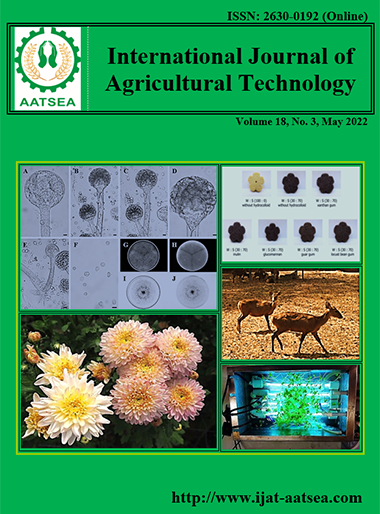Effect of storage temperature on the quality of live mud crabs
Main Article Content
Abstract
The chilling storage effect on the quality of live mud crabs was examined. The results showed that the chilling storage at 20ºC could decrease delayed loss of quality change with high remained glycogen (7.40±2.30 mg/100g), low accumulated lactate (9.75±0.12 mmol/kg) and 45.57±3.59 mgN/100g of VBN, while the pH decreased slightly average to 7.01±0.09. This condition is maintained muscle yield of 15.63±0.58% after 7 days. The total proximate compositions changed slightly during storage, the averaged between 78.10-79.10% of moisture content, 16.85-16.91% of protein, 0.10-0.22% of fat, and 1.4-1.54 % of ash on 4-7 days storage. Thus, result indicated that the 20ºC chilling storage can be benefit to the handling process and transport of mud crabs
Article Details

This work is licensed under a Creative Commons Attribution-NonCommercial-NoDerivatives 4.0 International License.
References
AOAC (1984). Official Methods of Analysis. 14th ed. The Association of Official Analytical Chemists, Virginia.
Barton, B. A. and Iwama, G. K. (1991). Physiological changes in fish from stress in aquaculture with emphasis on the response and effects of corticosteroids. Annual Review of Fish Diseases, 1:649-659.
Baylo, J. C. (2013). The combined effects of salinity and temperature on the survival and development of zoea, megalopa and crab instar larvae of mud crab, Scylla tranquebarica (Fabricius 1798). Asian Fisheries Science, 26:14-25.
Chiou, T. K. and Huang, J. P. (2003). Chemical constituents in the abdominal muscle of cultured mud crab Scylla serrata in relation to seasonal variation and maturation. Fisheries Sciences, 69:509-604.
Chiou, T. K. and Huang, J. P. (2004). Biochemical changes in the abdominal muscle of mud crab Scylla serrata during storage. Fisheries Sciences, 70:167-173.
Conway, E. J. (1950). Microdiffusion and volumetric error. London: Crosby Lockwood and Son.
Engel, P. C. and Jones, J. B. (1978). Causes and elimination of erratic blanks in enzymatic metabolite assays involving the use of NAD+ in alkaline hydrazine buffers: improved conditions for the assay of L-glutamate, L-lactate, and other metabolites. Analytical Biochem, 88:475-484.
Lorenzon, S., Giulianini, P.G., Martinis, M. and Ferrero, E. A. (2007). Stress effect of different temperatures and air exposure during transport on physiological profiles in the American lobster Homarus americanus. Comparative Biochemistry and Physiology A, 147:94-102.
Morris, S. and Oliver, S. (1999). Circulatory, respiratory and metabolic response to emersion and low temperature of Jasus edwardsii:simulation studies of commercial shipping methods. Comparative Biochemistry and Physiology, 122:299-308.
Ninlanon, W. and Nongnud Tangkrock-Olan, N. (2008). Effects of handling processes on the quality and biochemical changes in tissue of mud crab, (Scylla serrata, Forsskal, 1755) During Emersion Storage. EnvironmentAsia, 2:49-55.
Ninlanon, W. (2011). Effect of pre-cooling on muscle yield of mud crab, Scylla serrata, during emersion storage. 2nd International Conference on Biotechnology and Food Science IPCBEE, IACSIT Press, Singapore, 7:126-129.
Nurdiani, R. and Zeng, C. (2007). Effects of temperature and salinity on the survival and development of the mud crab, Scylla serrata (Forsskal), larvar. Aquaculture Research, 38:1529-1538.
Pascual, C., Sanchez, A., Sanchez, A., Vargas-Albores, F., LeMoullac, G. and Rosas, C. (2003). Haemolymph metabolic variables and immune response in Litopenaeus setiferus adult males; the effect of an extreme temperature. Aquaculture, 218:637-650.
Ridgway, I. D., Taylor, A. C., Atkinson, R. J. A., Stentiford, G. D., Chang, E. S., Chang, S. A. and Neil, D.M. (2006). Morbidity and mortality in Norway lobsters, Nephrops norvegicus: physiological, immunological and pathological effects of aerial exposure. Journal of Experimental Marine Biological and Ecology, 328:251-264.
Skudlarek, J. G., Coyle, S. O., Bright, L. A. and Tidwell, J. H. (2011). Effect of holding and packing conditions on hemolymph parameters of freshwater prawns, Macrobrachium rosenbergii, during simulated waterless transport. Journal of The World Aquaculture Society, 42:603-617.
Syafaat, M. N., Azra, M. N., Waiho, K., Fazhan, H., Abol-Munafi, A. B., Ishak, S. D., Syahnon, M., Ghazali, A., Ma, H. and Ikhwanuddin, M. (2021). A review of the nursery culture of mud crabs, Genus Scylla:current progress and future directions. Animals, 11:2034.
Tsai, M. L., Hsu, W. P. and Chen, T. C. (2019). Evaluation of suitable temperature range for post‐harvest processing of mud crabs through cardiac performance. Aquaculture Research, 50:3711-3719.


